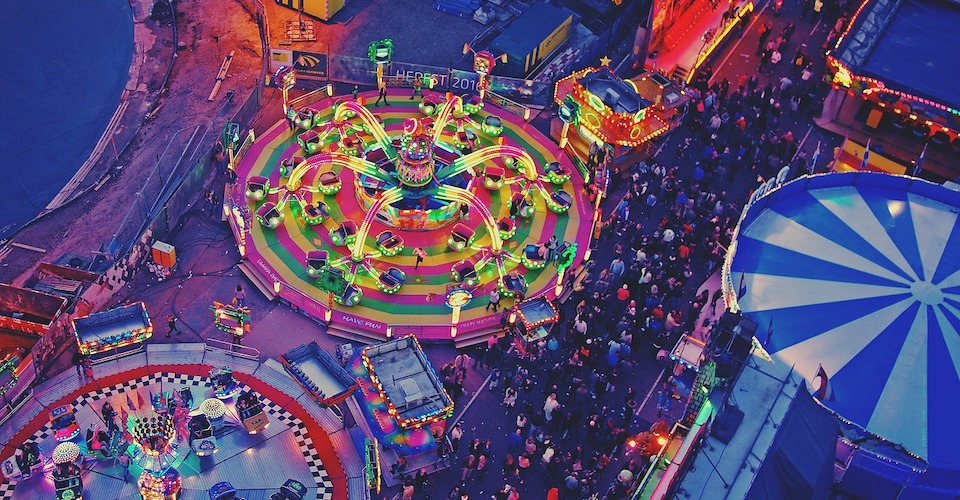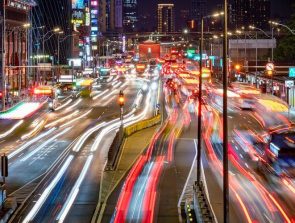Can I Legally Fly a Drone at Night?
One of the most fun things you can do with your drone is to fly it at night. Away from the brightness of daylight, you can just snap a few LED lights on your drone and turn in into a flying spectacle. However, the enactment of the Part 107 regulations two years ago put a kink into flying drones at night. Is there still a way to fly at night legally? Read on to find out how.
Why would I want to fly a drone at night?
The thing about flying a drone at night is that people have been doing it long before the Part 107 regulations were created. Most of it has been done for fun. On a clear and windless night, there are a few things more entertaining than sending up a colorful lit-up drone and just flying around to your heart’s content. Being able to take drone photos at night is also a sure-fire way to a get shots with a unique perspective.
More than just for leisure, there are a lot of possible commercial reasons for flying at night. For drone photographers, they may have a gig that requires them to shoot a wedding or sports event that will be held at night. This may also apply for drone photographers who work for real estate advertising, as some clients may request for aerial footage of their property against the night skyline.
Drone mapping services may also have to extend beyond daylight hours to finish surveying a large area. Security monitoring and surveillance using drones will almost certainly need to operate at night. Even routine inspection jobs may need to mobilize at night, especially for industries that normally operate 24/7.
The case FOR flying at night
For drone businesses, the ability to fly at night is absolutely essential. As already mentioned, opportunities and clients will come up inevitably where an organization or individual will need to fly a drone at night. Without a provision for flying at night or having to undergo an approval process that takes too long, drone businesses will lack the flexibility to serve client needs.
The main argument against flying at night has to do with the safety of flying a drone without the visibility that daylight offers. To address these, many manufacturers have come up with anti-collision LED lights that can be attached to any drone model. Some hobby drone manufacturers have even come to recognize the appeal of flying at night and have designed their drones with pre-installed LED lighting systems.
Some drone pilots have claimed that, with the appropriate lighting system, drone visibility is even better at night. There is some merit to this argument. Against the pitch-black night sky, a lighted up drone is still very visible even at the edge of 3 statute mile range that you are allowed to fly in.
Most areas are much less populated during the night than at day, so the chances of a crash resulting in personal injury are also reduced. Of course, this argument does not apply for areas that are still packed with people at night, such as commercial areas or a sports stadium. However, if you want to fly around with a drone in an open field during night time, then you probably don’t need to worry about hurting anyone.
The case AGAINST flying at night
The thing about a flying bright object at night is that onlookers may react to it in a number of unpredictable ways. Collected news reports in 2017 showed a sudden spike in UFO sightings which were ascribed to drones being flown at night. People nowadays are more concerned with privacy and security issues, so having a drone fly around a populated area during nighttime might cause undue anxiety and panic. This can be especially true for drones with onboards cameras.
Although LED lights provide enough visibility for a pilot to see his or her drone at all times, they are not enough to see all obstacles that the drone can crash into. Trees, birds, electrical wires – even a skilled drone pilot can inadvertently crash into these obstacles as none of them are illuminated. That being said, flying at night is inherently tricky and must only be reserved for experienced and skilled drone pilots.
Most important of all, flying a drone at night is against the Part 107 regulations. If you are discovered to be flying a drone at night without the proper authorization, the FAA may issue a hefty penalty and have your drone confiscated. It may also get you in trouble with local law enforcement
How can I get a waiver to legally fly at night?
Fortunately, the FAA has anticipated the business needs to fly drones at night. Incorporated into Part 107 is the provision to ask for waivers for particular regulations, given sufficient justification and mitigation of risks. A waiver may be requested by a commercial drone pilot to waive the rule against flying at night, among others.
So how does one go about securing this waiver? If you are already a Part 107 licensed drone pilot, all you have to do to is visit the FAA’s DroneZone portal and file your waiver request. After providing a descriptive title for your activity, the names of the Person Responsible and the Remote Pilot, you will be asked to provide a detailed description of the operations, an identification of the risks involved, and the appropriate mitigating measures you intend to implement.
The best advice we can give when filing your Part 107 waiver is to be as detailed as possible. You should describe what time and for how long you intend to fly, where exactly you will fly (complete with a map and coordinates), what the capabilities of your drone are, and what your capabilities are as a drone pilot. For nighttime flying, you will specifically have to address how you are going to maintain visual contact with the drone given that you will be flying in pitch-black conditions.
One of the most important requirements in being approved for nighttime flight is the installation of anti-collision lights on your drone. Most drones come with their own lighting systems, but after-market strobe lights are usually brighter and more effective. When installing after-market lights, take note of how heavy they are (including their power source), how they will attach to your drone (straps, double-sided tape, etc.), how many you need to install on a single drone, and if they are weather-proof. Red strobe lights do not interfere with night vision but white strobe-lights are much more visible – most drone pilots opt for a combination of both. You may also want to invest in an external GPS tracker, which may help you locate your drone even if it crashes due to dead batteries.
Take note that the FAA may take up to 90 days to decide on whether or not to approve your waiver request. They may also get in contact with you within the 90 days to ask for additional information, so make sure to keep your lines of communication open and be prompt in your responses.
The FAA has the right to approve or decline any waiver request as they deem fit. However, you may take comfort in the fact that the FAA has approved more than 1,800 waiver requests for nighttime flight ever since the passing of the Part 107 regulations. This figure represents more than 90% of all waiver requests that the FAA granted, so you should statistically be in a very good position.
What if I fly just for fun?
The ironic thing about the Part 107 regulations is that you are NOT required to abide by them if you are not a licensed drone pilot or if you are not flying for profit. If you are flying strictly for fun, then go right ahead and fly your drone at night. There is a caveat to this, though. There is a fine line between flying for fun and flying commercially, and you may cross that line more easily than you think. You may be taking pictures just for posting on your social media account, but someone may approach you and offer to buy that particularly good photo and suddenly – you’re an illegal commercial drone pilot.
One thing to keep in mind: even if you’re not covered by Part 107, there is such a thing as the responsible use of drones. The FAA regulations will not protect you from liability if your drone ends up crashing and damaging your neighbor’s car or hurting an unwitting pedestrian. Flying over your neighbors’ backyards at night is sure to raise a few eyebrows, and you probably don’t want cops knocking at your door in the name of having fun.
If you’re a licensed drone pilot just out flying for fun, keep in mind that being involved in a drone-related accident can probably compromise your status as a licensed drone pilot. If you are found to be in violation of any Part 107 regulations, the FAA reserves the right to revoke your drone license.
Final thoughts
Flying at night is probably one of the most fun things people look forward to doing when they get their drones. You basically have a flying light show that you can control – what could be better than that? However, the Part 107 regulations have put some restrictions on night flight so it’s no longer something that commercial drone pilots can do on a whim.
Fortunately, the FAA has been pretty lenient on granting waivers for nighttime flight. With the right equipment and a sufficiently skilled pilot, the risks of flying at night can be easily overcome.
For hobby drone pilots, there is very little in way of laws that can stop you from flying at night. However, we suggest practicing some due diligence to avoid running issues with your neighbors or with the local law enforcement. Remember, no amount of fun is worth sacrificing personal and property safety.




Good article
This finally answered a couple of questions I have had for a bit, good article!